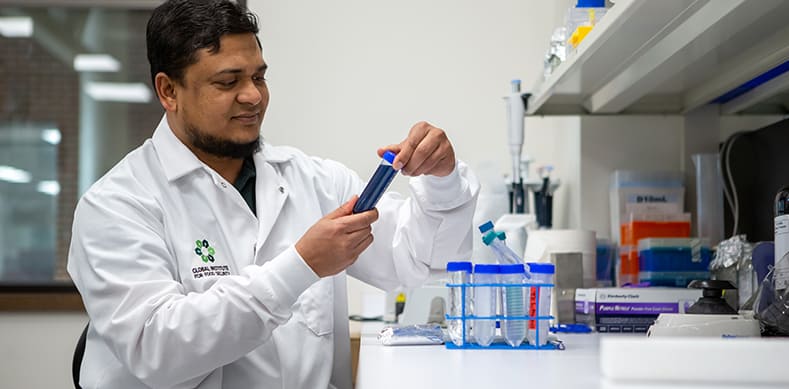
Hasan Ahmed in the lab (Credit: Josh Schaefer//GetMyPhoto.ca)
Hasan Ahmed knew part of the picture was missing.
Working in Saskatchewan’s private sector with a canola breeding team in 2017, the Bangladesh native noticed that efforts to improve crop varieties were focused almost solely on the traits that breeders could easily see – the stems and appendages of plants known as their shoots.
But what about the parts of plants buried in soil and inherently difficult to study—the root systems?
“I knew that taking a closer look at what is often referred to as the plant’s ‘hidden half’ could open new doors to improved canola varieties,” said Ahmed.
He got his opportunity later in 2017, when he learned that celebrated researcher Dr. Leon Kochian (PhD) had recently moved from Cornell University to the University of Saskatchewan (USask) and the Global Institute for Food Security (GIFS). One of the world’s most highly cited researchers, Kochian is a leading expert in root biology, structure and function.
So Ahmed took a chance, leaving his private sector job in plant breeding to pursue a PhD on Canola root systems under the leadership of Kochian at GIFS.
Fast-forward to 2020 and that decision is beginning to pay off for GIFS’ new International Program Development Manager.
“I knew USask was advancing to become the top institution in Canada in plant science and agricultural research, and I wanted to be part of this advancement.”
Fields of Gold
Canola is Canada’s most valuable crop.
Developed by researchers from Agriculture and Agri-Food Canada and the University of Manitoba in the 1970s, its name is a contraction of Canada and ola, meaning oil. The plant belongs to the Brassica genus, the botanical family that includes cauliflower and cabbages.
Since the 1970s, canola has become one of the world’s most important oilseeds due to its healthy oil and high-quality protein. Canada remains the most prominent producer of the bright-yellow crop, exporting over 90 per cent of its canola production as seeds, oil and meal.
According to Saskatchewan’s Ministry of Agriculture, over 10 million acres of canola were sown in Saskatchewan alone in 2016, resulting in exports of almost $3 billion.
In the lab, the world’s only “Made in Canada” crop also stands out as unique.
Ahmed and his team at GIFS found that canola is the only plant species to exhibit dramatic differences in root composition when grown in soil as opposed to soilless tubs of water and nutrients (hydroponics). In soil, the root systems are dominated by stubby and thick roots; in hydroponics, the root systems are luxuriously fine with hundreds of long and thin lateral roots.
This plasticity represented an opportunity for Ahmed. He knew that if he could identify the material and molecular triggers for this transition, he could open up opportunities to develop root systems better suited for mining the soil for water and nutrients.
The potential implications of this improvement for canola producers, farmers, and the general public could be significant—not just for higher yield but also for combatting climate change.
“Improved root systems that can more efficiently acquire nutrients and water means canola varieties that are more resilient to drought and that maintain high yields with less fertilizer inputs,” said Ahmed.
“We have a chance to reduce fertilizer costs as well as the negative environmental effects that occur when these fertilizers leach into ground and surface waters.”
Efficient nitrogen uptake will also reduce the release of potent greenhouse gases such as nitrogen oxide that are generated by microbial activity on nitrogen fertilizers.
It’s these opportunities to make a difference in the world that drive Ahmed, who is helping connect GIFS work to the world as the International Program Development Manager.
“I want to do something through my research that is beneficial to society and humankind,” said Ahmed. “I realize that improving crops will help to achieve food security to meet the growing needs of humanity. Working towards this dream inspires me to work sincerely in my life.”

Hasan Ahmed in a Global Institute for Food Security (GIFS) lab (Credit: Josh Schaefer//GetMyPhoto.ca)
Ahmed is testing a pair of hypotheses: that the difference between increased resistance in soil and reduced resistance in hydroponics influences differences in root growth and development; and that the lack of fully developed root microbiome in hydroponically grown plants plays a role in the absence of thicker and shorter roots typically seen in soil.
The first step of the project has been to focus on optimizing growth conditions in the lab that more closely mimic field conditions. By producing root systems in hydroponics similar to those grown in soil, Ahmed is seeking to discover the physiological basis for the transition, both with regards to plant nutrition and to the physical and biological properties of the soil.
If root microbiome is confirmed to contribute to the response, he will be able to pass the torch to soil microbiologists already working in Kochian’s group and at USask.
The potential to tap into the considerable talent and resources available on the USask campus was one of the many reasons that the university was an easy choice for Ahmed.
“To receive a world-class education in plant physiology, molecular genetics and root research, I knew I would need to attend a school where the latest techniques and best practices are taught,” said Ahmed.
“I knew USask was advancing to become the top institution in Canada in plant science and agricultural research, and I wanted to be part of this advancement.”
